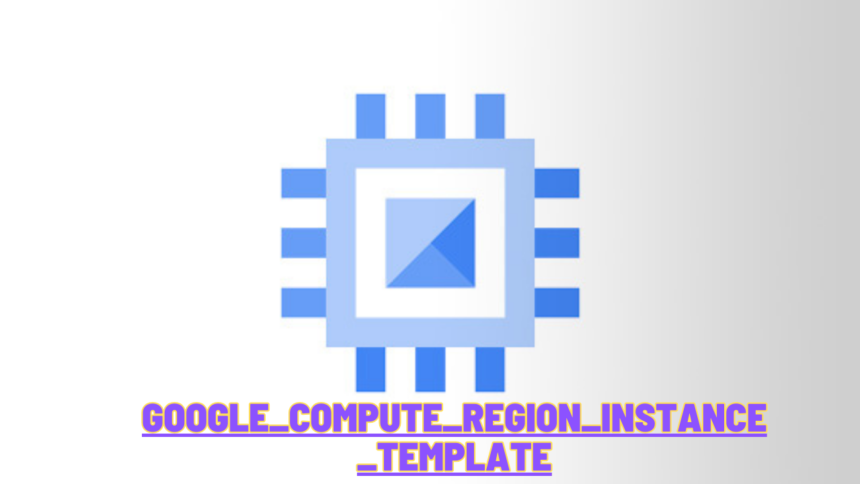
Introduction to Google_compute_region_instance_template
In the evolving world of cloud computing, Google Compute Engine is a standout provider from Google Cloud Platform (GCP) that offers a versatile and effective infrastructure as a provider (IaaS). At the coronary heart of this provider lies the Google_compute_region_instance_template, a key characteristic designed to simplify the deployment and management of virtual gadget (VM) times across numerous areas. This article will dive into the info of Google_compute_region_instance_template, dropping mild on its capabilities, benefits, and nice practices for powerful use.
What is Google_compute_region_instance_template?
The Google_compute_region_instance_template is a crucial tool for defining the configuration of VM instances within Google Cloud. Essentially, it’s a blueprint that outlines parameters such as system kind, boot disk photograph, community settings, and extra. By using these templates, you may ensure uniformity throughout a couple of VM instances and automate their deployment, making it less complicated to control and scale your cloud infrastructure.
Key Features of Google_compute_region_instance_template
1. Consistency and Standardization
Instance templates provide a consistent configuration across all VM instances, ensuring that every instance adheres to the same specifications. This uniformity is essential for maintaining reliable performance and simplifying management tasks.
2. Scalability
With instance templates, scaling your applications becomes straightforward. You can quickly create numerous instances with identical configurations, which is especially useful for scenarios requiring load balancing and autoscaling.
3. Ease of Management
Managing VM configurations is streamlined with instance templates. Updates to the template automatically apply to all instances derived from it, reducing administrative overhead and simplifying maintenance.
4. Improved Deployment Speed
Templates expedite the deployment process by eliminating the need for manual configuration of each VM instance. This efficiency is crucial for large-scale rollouts and rapid prototyping.
Creating a Google_compute_region_instance_template
Setting up a Google_compute_region_instance_template is a easy technique, whether or not you are using the Google Cloud Console, gcloud command-line device, or the Compute Engine API. Here’s a step-via-step guide the usage of the Google Cloud Console:
Navigate to the Google Cloud Console
Log into the Google Cloud Console and select your project.
Go to the Compute Engine Section
In the navigation menu, select Compute Engine > Instance templates.
Create an Instance Template
Click the “Create instance template” button. Fill out the required fields such as name, machine type, boot disk, and network settings.
Configure the Template
Machine Type: Choose the machine type suited to your workload.
Boot Disk: Select the boot disk image and size, which can be a public image, custom image, or snapshot.
Network Settings: Configure the network and subnetwork settings, including firewall rules and IP configurations.
Review and Create
Review your configurations and click “Create” to finalize the template.
Best Practices for Using Google_compute_region_instance_template
To maximize the benefits of Google_compute_region_instance_template, keep these best practices in mind:
1. Consistent Naming Conventions
Use clear and consistent naming conventions for your instance templates to simplify identification and management. This practice aids in troubleshooting and resource organization.
2. Regular Updates and Maintenance
Regularly update your instance templates to integrate new configurations, security patches, and optimizations. This ensures that all VM instances remain secure and up-to-date.
3. Utilize Labels for Organization
Apply labels to your instance templates for better organization and categorization. Labels, which are key-value pairs, help in filtering and grouping resources efficiently.
4. Implement Auto Scaling Policies
Use instance templates to set up auto scaling policies that adjust the number of VM instances based on demand. This optimizes resource use and cost management.
5. Backup and Recovery Strategies
Develop backup and recovery plans for your instance templates. This includes creating snapshots and custom images to protect your configurations and data.
Advantages of Google_compute_region_instance_template
1. Cost Efficiency
Instance templates help in optimizing resource allocation and cutting costs by avoiding over-provisioning and ensuring efficient resource usage.
2. High Availability
By enabling deployment across multiple regions, instance templates enhance service availability and resilience, reducing the risk of downtime due to regional failures.
3. Simplified Management
Managing VM instances through templates streamlines administrative tasks, allowing for bulk updates and centralized control, thereby reducing complexity.
Use Cases for Google_compute_region_instance_template
1. Web Application Deployment
Instance templates are perfect for deploying web applications that need multiple VM instances with identical settings, ensuring consistent performance and reliability.
2. Batch Processing
For tasks like data analysis or rendering, instance templates facilitate the quick creation of multiple instances to handle substantial workloads efficiently.
3. Disaster Recovery
Instance templates are integral to disaster recovery strategies. They allow for rapid deployment of new instances with predefined configurations, ensuring business continuity in case of failures.
Conclusion
The Google_compute_region_instance_template is a powerful asset within Google Cloud, offering enhanced efficiency, consistency, and scalability for VM instance deployments. By leveraging its features and adhering to best practices, you can optimize your cloud infrastructure and streamline operations. Whether you’re deploying web applications, managing batch processing, or preparing for disaster recovery, instance templates provide a solid foundation for your cloud-based initiatives.

